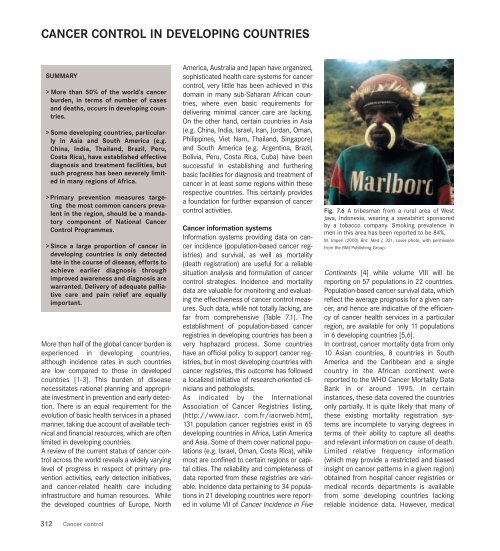world cancer report - iarc
world cancer report - iarc
world cancer report - iarc
You also want an ePaper? Increase the reach of your titles
YUMPU automatically turns print PDFs into web optimized ePapers that Google loves.
CANCER CONTROL IN DEVELOPING COUNTRIES<br />
SUMMARY<br />
> More than 50% of the <strong>world</strong>’s <strong>cancer</strong><br />
burden, in terms of number of cases<br />
and deaths, occurs in developing countries.<br />
> Some developing countries, particularly<br />
in Asia and South America (e.g.<br />
China, India, Thailand, Brazil, Peru,<br />
Costa Rica), have established effective<br />
diagnosis and treatment facilities, but<br />
such progress has been severely limited<br />
in many regions of Africa.<br />
> Primary prevention measures targeting<br />
the most common <strong>cancer</strong>s prevalent<br />
in the region, should be a mandatory<br />
component of National Cancer<br />
Control Programmes.<br />
> Since a large proportion of <strong>cancer</strong> in<br />
developing countries is only detected<br />
late in the course of disease, efforts to<br />
achieve earlier diagnosis through<br />
improved awareness and diagnosis are<br />
warranted. Delivery of adequate palliative<br />
care and pain relief are equally<br />
important.<br />
More than half of the global <strong>cancer</strong> burden is<br />
experienced in developing countries,<br />
although incidence rates in such countries<br />
are low compared to those in developed<br />
countries [1-3]. This burden of disease<br />
necessitates rational planning and appropriate<br />
investment in prevention and early detection.<br />
There is an equal requirement for the<br />
evolution of basic health services in a phased<br />
manner, taking due account of available technical<br />
and financial resources, which are often<br />
limited in developing countries.<br />
A review of the current status of <strong>cancer</strong> control<br />
across the <strong>world</strong> reveals a widely varying<br />
level of progress in respect of primary prevention<br />
activities, early detection initiatives,<br />
and <strong>cancer</strong>-related health care including<br />
infrastructure and human resources. While<br />
the developed countries of Europe, North<br />
312 Cancer control<br />
America, Australia and Japan have organized,<br />
sophisticated health care systems for <strong>cancer</strong><br />
control, very little has been achieved in this<br />
domain in many sub-Saharan African countries,<br />
where even basic requirements for<br />
delivering minimal <strong>cancer</strong> care are lacking.<br />
On the other hand, certain countries in Asia<br />
(e.g. China, India, Israel, Iran, Jordan, Oman,<br />
Philippines, Viet Nam, Thailand, Singapore)<br />
and South America (e.g. Argentina, Brazil,<br />
Bolivia, Peru, Costa Rica, Cuba) have been<br />
successful in establishing and furthering<br />
basic facilities for diagnosis and treatment of<br />
<strong>cancer</strong> in at least some regions within these<br />
respective countries. This certainly provides<br />
a foundation for further expansion of <strong>cancer</strong><br />
control activities.<br />
Cancer information systems<br />
Information systems providing data on <strong>cancer</strong><br />
incidence (population-based <strong>cancer</strong> registries)<br />
and survival, as well as mortality<br />
(death registration) are useful for a reliable<br />
situation analysis and formulation of <strong>cancer</strong><br />
control strategies. Incidence and mortality<br />
data are valuable for monitoring and evaluating<br />
the effectiveness of <strong>cancer</strong> control measures.<br />
Such data, while not totally lacking, are<br />
far from comprehensive (Table 7.1). The<br />
establishment of population-based <strong>cancer</strong><br />
registries in developing countries has been a<br />
very haphazard process. Some countries<br />
have an official policy to support <strong>cancer</strong> registries,<br />
but in most developing countries with<br />
<strong>cancer</strong> registries, this outcome has followed<br />
a localized initiative of research-oriented clinicians<br />
and pathologists.<br />
As indicated by the International<br />
Association of Cancer Registries listing,<br />
(http://www.iacr. com.fr/iacrweb.htm),<br />
131 population <strong>cancer</strong> registries exist in 65<br />
developing countries in Africa, Latin America<br />
and Asia. Some of them cover national populations<br />
(e.g. Israel, Oman, Costa Rica), while<br />
most are confined to certain regions or capital<br />
cities. The reliability and completeness of<br />
data <strong>report</strong>ed from these registries are variable.<br />
Incidence data pertaining to 34 populations<br />
in 21 developing countries were <strong>report</strong>ed<br />
in volume VII of Cancer Incidence in Five<br />
Fig. 7.6 A tribesman from a rural area of West<br />
Java, Indonesia, wearing a sweatshirt sponsored<br />
by a tobacco company. Smoking prevalence in<br />
men in this area has been <strong>report</strong>ed to be 84%.<br />
M. Imperi (2000) Brit. Med J, 321, cover photo, with permission<br />
from the BMJ Publishing Group.<br />
Continents [4] while volume VIII will be<br />
<strong>report</strong>ing on 57 populations in 22 countries.<br />
Population-based <strong>cancer</strong> survival data, which<br />
reflect the average prognosis for a given <strong>cancer</strong>,<br />
and hence are indicative of the efficiency<br />
of <strong>cancer</strong> health services in a particular<br />
region, are available for only 11 populations<br />
in 6 developing countries [5,6].<br />
In contrast, <strong>cancer</strong> mortality data from only<br />
10 Asian countries, 8 countries in South<br />
America and the Caribbean and a single<br />
country in the African continent were<br />
<strong>report</strong>ed to the WHO Cancer Mortality Data<br />
Bank in or around 1995. In certain<br />
instances, these data covered the countries<br />
only partially. It is quite likely that many of<br />
these existing mortality registration systems<br />
are incomplete to varying degrees in<br />
terms of their ability to capture all deaths<br />
and relevant information on cause of death.<br />
Limited relative frequency information<br />
(which may provide a restricted and biased<br />
insight on <strong>cancer</strong> patterns in a given region)<br />
obtained from hospital <strong>cancer</strong> registries or<br />
medical records departments is available<br />
from some developing countries lacking<br />
reliable incidence data. However, medical

















